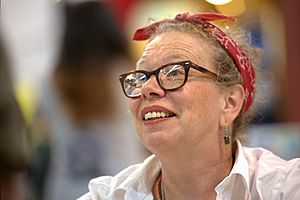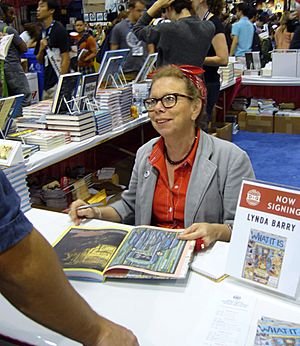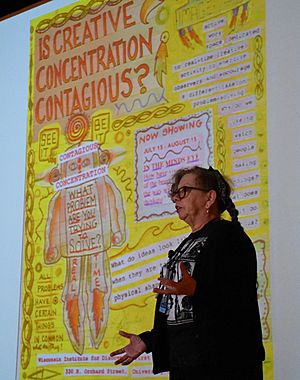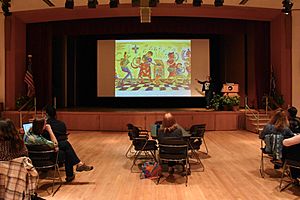Lynda Barry facts for kids
Quick facts for kids Lynda Barry |
|
|---|---|

At the 2010 Alternative Press Expo
|
|
| Born | Linda Jean Barry January 2, 1956 Richland Center, Wisconsin, U.S. |
| Nationality | American |
| Area(s) | Cartoonist, Writer |
|
Notable works
|
Ernie Pook's Comeek The Good Times Are Killing Me One! Hundred! Demons! |
Lynda Barry (born January 2, 1956) is a famous American cartoonist and writer. She is best known for her weekly comic strip called Ernie Pook's Comeek.
Lynda Barry also wrote illustrated novels like The Good Times are Killing Me, which became a play. Her graphic novel What It Is won a big award called the Eisner Award in 2009. This book helps people discover their own creativity.
Because of her amazing work in comics, Lynda Barry has received many honors. She was inducted into the Eisner Hall of Fame in 2016. In 2019, she received a special award called the MacArthur Fellowship. Today, she teaches creativity at the University of Wisconsin–Madison.
Contents
Early Life and School Days
Lynda Barry was born Linda Jean Barry in Richland Center, Wisconsin. When she was 12, she changed her first name to Lynda.
She grew up in Seattle, Washington, in a diverse neighborhood. Lynda's father worked with meat, and her mother was a hospital housekeeper. Lynda remembers her childhood as being a bit tough.
When she was in high school, she worked nights cleaning a hospital. After high school, she went to The Evergreen State College in Olympia, Washington. There, she met another cartoonist named Matt Groening, who later created The Simpsons.
Lynda's career in comics began in 1977. Matt Groening and another student editor published her drawings in their college newspapers. They called her comic strip Ernie Pook's Comeek.
Lynda Barry's Career
Starting in Comics
Lynda Barry was known as the class cartoonist even when she was in grade school.
While studying art in college, she started drawing comic strips a lot. Her first comic strip was published in her college newspaper in 1977. These were the comics that Matt Groening and John Keister published as Ernie Pook's Comeek.
After college, Lynda moved to Seattle. When she was 23, a newspaper called the Chicago Reader started publishing her comic strip. This allowed her to make a living from her comics. She later moved to Chicago, Illinois.
Lynda explained that her big break was mostly luck. Matt Groening helped her get her comics noticed. Soon, other newspapers started printing her work too.
Some of her early comic collections include Girls & Boys (1981) and The Fun House (1987). By 1989, her comic strip appeared weekly in over 50 newspapers.
Lynda Barry says she doesn't plan her stories too much beforehand. She lets the story develop as she draws and writes. She believes her mind can create the story order naturally.
Around 2007, Lynda started publishing her comics mostly online. This happened because many weekly newspapers stopped printing them.
Her Books
Lynda Barry's comic collections started being published in 1981. She has also written two illustrated novels. These are The Good Times are Killing Me (1988) and Cruddy (1999).
Cruddy is told from the point of view of a fictional girl named Roberta. The book follows her on some wild adventures with her father. Critics really liked this book.
Lynda also turned her novel The Good Times are Killing Me into a play.
Another graphic novel is One! Hundred! Demons! (2002). This book was inspired by an old Zen painting exercise. In this exercise, artists paint "demons" or difficult feelings as they come to mind. Lynda's book explores feelings like regret and self-consciousness. It also encourages readers to try drawing and writing themselves. Time magazine said the book uses humor to explore the challenges of growing up.
Lynda Barry has also written four books about how to be creative. These books are Making Comics, What It Is, Picture This, and Syllabus. They focus on helping people find their own creative paths. Publishers Weekly praised Syllabus as a great guide for breaking out of old habits.
Other Creative Work
Lynda Barry's illustrated novel The Good Times are Killing Me was adapted into an off-Broadway play. The play ran for many performances in New York City in 1991. Actors in the play won awards for their roles.
In 1991, Lynda Barry wrote an essay called "War" for Mother Jones magazine. In it, she spoke about how war affects people. She said that war becomes part of our lives when other peaceful choices could be made.
Workshops and Teaching

Lynda Barry teaches workshops called "Writing the Unthinkable." In these workshops, she shares her creative process. She holds about 15 writing workshops across the country each year. She learned many of these techniques from her college teacher, Marilyn Frasca. Many of her ideas are in her book What It Is.
A New York Times article about her workshops said that Lynda helps people find where ideas come from. Her goal is to help everyone use their natural creativity.
In 2012, Lynda Barry was an artist-in-residence at the University of Wisconsin–Madison. She taught a class there about shifting images. In 2013, she joined the university as a professor in the art department.
Personal Life
Lynda Barry is married to Kevin Kawula, who is an expert in restoring prairies. They met while she was working at an art foundation. In 2002, they moved to a dairy farm in Footville, Wisconsin.
Lynda Barry has spoken out about wind turbines. She has asked the Wisconsin government for clearer rules about building turbines near homes. She has also talked about problems like noise pollution from turbines.
In 1994, Lynda Barry became very sick with dengue fever.
Awards and Honors
- 1988 Inkpot Award
- 2004 Women Cartoonists Hall of Fame
- 2009 Eisner Award: Best Reality-Based Work for What It Is
- 2019 MacArthur Fellow
Selected Books by Lynda Barry
- Girls and Boys (1981) ISBN: 0-941104-00-1
- Big Ideas (1983) ISBN: 0-941104-07-9
- The Good Times Are Killing Me (1988) ISBN: 0-941104-22-2
- Cruddy (1999) ISBN: 978-0684865300
- One! Hundred! Demons! (2002) ISBN: 9781570613371
- What It Is (2008) ISBN: 978-1897299357
- Syllabus: Notes from an Accidental Professor (2014) ISBN: 978-1770461611
- Making Comics (2019) ISBN: 978-1770463691



